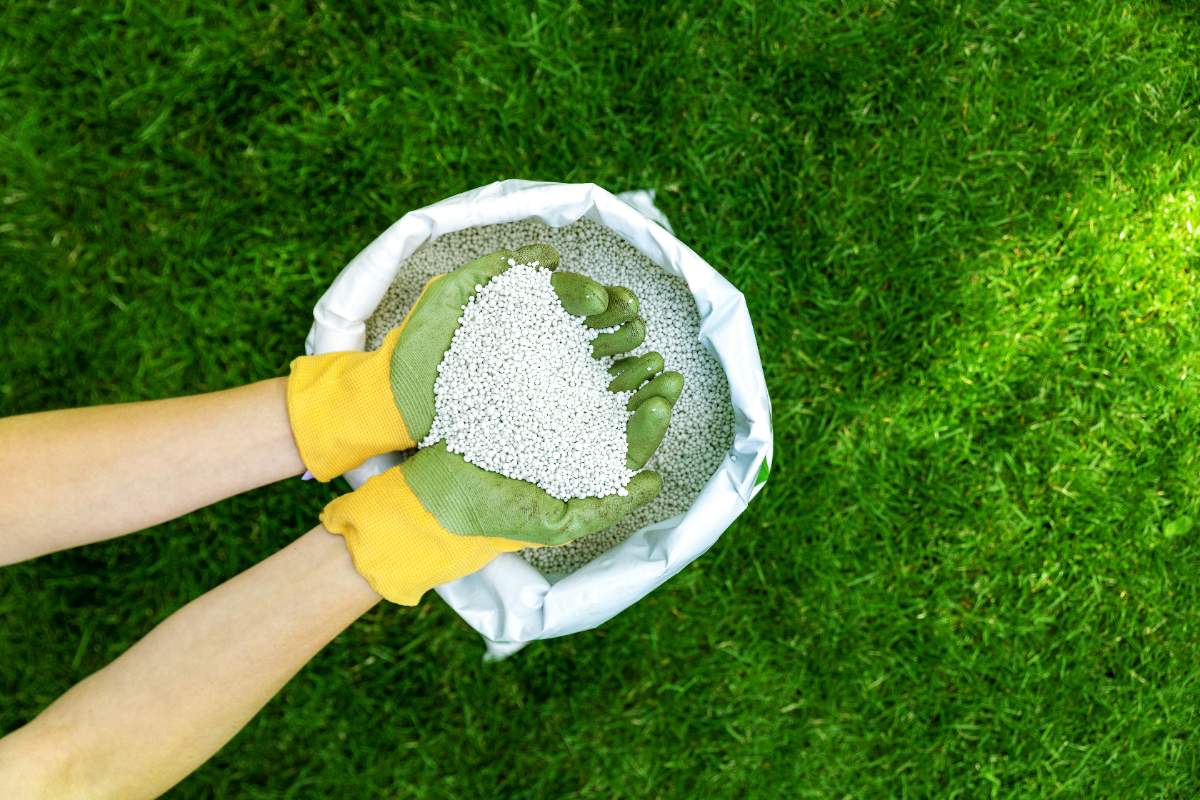
Fall fertilization is a crucial part of lawn care. It provides essential nutrients to repair damage from the summer heat, enhances its overall health, and prepares it for winter survival and spring recovery.
7 Important Reasons to Use Fall Fertilizer
To better understand the importance of fall fertilization, I reached out to Bryan Hopkins, a professor at Brigham Young University. He explains that fall fertilization helps grass achieve three essential goals: “(1) enter winter healthy and better resist winterkill, (2) green up faster and stronger in spring, and (3) develop deeper, denser root systems to better handle summer heat.”
These goals are achieved through the following 7 benefits.
Repairs Summer Damage

Summer stressors like heat, drought, foot traffic, and pest activity take a heavy toll on your lawn. Fall fertilizer provides the grass with the necessary nutrients to help it recover from these seasonal stresses.
Well-renowned in turfgrass science, Hopkins adds that fall fertilizer is especially critical for cool-season grasses: “Fall nitrogen is the single most important fertilizer application of the year. This is when lawns recover from summer stress, grow roots, and store carbohydrates to survive winter.”
Nitrogen helps repair thin or bare spots by encouraging thicker, denser turf regrowth and boosting root strength; phosphorus supports root repair; and potassium aids in overall plant recovery.
The cooler temperatures and increased rainfall in autumn create optimal conditions for nutrient uptake, allowing damaged areas to recoup and regenerate.
Enhances Root Development
As air temperatures start to drop, grass redirects its energy from leaf growth to root development in preparation for winter dormancy. Late-season fertilizers, especially those higher in phosphorus and potassium than in nitrogen, provide the nutrients needed for this proliferation of root growth.
This enhanced root network also improves the lawn’s ability to access water and nutrients, promoting improved health and vigor in the following spring.
| Whether you’re short on time or equipment, you can hire a LawnStarter fertilization pro to apply your fall fertilizer. Lawn treatments cost around $103, on average. With an average customer rating of 4.4, you can trust someone else to help prepare your lawn for winter. |
Promotes Thicker Turf Density
Cool-season grasses naturally increase tillering (producing new shoots from the base) and lateral growth during fall. Focusing on lateral instead of vertical growth is an evolutionary adaptation that helps the plant survive winter by creating more growing points.
As this growth naturally occurs, fertilizing in the fall further promotes it, resulting in denser turf coverage. This dense growth helps fill in thin areas, creating a thick, lush lawn most homeowners strive for.
Denser turf also helps naturally suppress common lawn weeds by leaving fewer open spaces for weed seeds to germinate and establish.
Increases Drought Resistance

There is a direct correlation between improved drought resistance and the development of deep, well-developed root systems. This relationship occurs because roots that grow down into deeper soil layers can access moisture that remains there when the weather is hot and dry.
Fall fertilization with phosphorus encourages root systems to grow deeper into the soil profile. The potassium in quality fall fertilizer products also strengthens cell walls, improving the grass’s water retention capabilities.
Note: While you can’t do much in the fall to go back and prevent summer drought stress, get a jump on next year by learning about lawn care during a drought.
Increases Disease Resistance

It’s no surprise that a healthy, well-nourished lawn naturally resists disease pressure better than a stressed and undernourished lawn. Similar to vitamins and supplements we take, fall fertilization supplies the essential nutrients required for natural defense mechanisms and cellular repair, enhancing plant immunity.
Balanced nutrition also keeps grass from creating overly succulent above-ground tissue that is highly attractive (and susceptible) to fungal pathogens like red thread and snow mold.
Additionally, strong root systems and improved plant vigor help a lawn recover more quickly from minor lawn diseases, preventing small issues from becoming major concerns.
Improves Winter Hardiness
A plant’s ability to survive through the winter depends mainly on energy reserves stored in its roots as it enters winter dormancy. Fall fertilizer helps grass accumulate carbohydrates and proteins essential for surviving freezing temperatures, ice formation, and snow cover.
Potassium plays a particularly vital role in winter hardiness. It helps regulate water movement within plant cells and prevents the formation of ice crystals that can rupture delicate cell walls.
Well-fertilized warm-season grasses also experience less winterkill in the event of unexpected, harsh winter storms.
Improves Spring Greenup
One of the most visible benefits of fall fertilization is the dramatic improvement you see in spring emergence and color development.
Grass that receives fall nutrition tends to break dormancy earlier in the spring and achieve full green color 2 to 6 weeks sooner than unfertilized turf. This happens because the nutrients stored in the roots over the winter fuel rapid, immediate spring growth, as opposed to the delayed response seen with spring-only fertilizer programs.
Early greenup creates an advantageous environment, suppressing weeds that try to germinate and establish early in the season. It also allows you to enjoy your lawn for an extended period.
FAQ About Applying Fall Fertilizer to Your Lawn
Cool-season grasses like Kentucky bluegrass and fine fescue should be fertilized about 6 to 8 weeks before the ground freezes and again as your grass is going dormant (when soil temperatures drop below 50 degrees Fahrenheit). Specific dates vary, but for most regions this is typically September for the first application and late October to late November for the second..
For instance, here in southeast Idaho, the first frost usually occurs in the second week of October; fall fertilization is recommended the week our kids return to school or around Labor Day weekend and then again the first or second week in October.
Warm-season grasses such as St. Augustine and Zoysia benefit from fall fertilizer, but they “follow a different schedule,” Hopkins notes. “They need a steadier supply of nitrogen throughout the growing season,” he says, and benefit from a final application between mid-August and mid-September as temperatures begin to cool.
Yes, newly seeded lawns benefit immensely from fall fertilizer, but you want to use a starter blend specially formulated for new grass. It will contain high phosphorus to promote root growth.
Avoid high-nitrogen fertilizers that can burn tender seedlings, and wait 4 to 6 weeks post-germination before applying them to give your grass time to establish.
It depends on when you realize you missed part of your fall lawn care checklist. As Hopkins notes, “Homeowners often mentally check out on lawn care” as the season progresses, making it easy to miss the window. However, a late application can still be beneficial — although less effective — if conditions still allow.
You won’t see full benefits, but as long as the soil hasn’t frozen, the grass can absorb some nutrients. Still, “Fall fertilization is critical,” Hopkins says, so it’s worth applying, even late.
If the ground has frozen, skip fall treatment and focus on an early spring fertilizer to compensate.
Signs your lawn needs a boost of nutrients before winter include thin or sparse areas, slow recovery from summer stress, poor color, or a history of winter damage. Truthfully, though, most established lawns benefit from fall fertilization, regardless of their appearance.
Soil testing can provide you with definitive nutrient information, helping you determine the optimal fertilizer rates.
No, fall fertilizers have a different nutrient ratio than spring ones. Fall products typically contain less nitrogen and more potassium than spring blends. After all, you’re encouraging better root growth and resource storage, not blade growth.
Look for fertilizer number ratios around 4-1-2 or even 1-2-1 for the late-season application.
Leave Fall Lawn Care to the Pros

Don’t let your lawn suffer through winter unprepared. LawnStarter connects you with trusted local LawnStarter lawn care professionals who can handle fall fertilization and other items on your autumn lawn care checklist. Get matched with top-rated pros in your area today for a healthier, more beautiful lawn next spring.
Sources
- Bryan Hopkins, professor and Certified Professional Soil Scientist at Brigham Young University, Provo, UT. Personal interview.
- “Benefits of Late Fall Fertilization.” By A. J. Koski, professor at Colorado State University, and John R. Street, professor of agronomy at The Ohio State University. The Ohio State University College of Food, Agricultural, and Environmental Sciences.
Main Image: Granular fertilizer. Image Credit: ronstik / Adobe Stock